v12.07.14
Art, Architecture and Design
This article spotlights a particular building or some other aspect of Columbus design. I welcome your comments, corrections and additions. Please share your experience and perceptions of these uniquely Columbus projects.
 North Christian Church
North Christian Church
- Built: 1964
- Principal Design Architect: Eero Saarinen (Eero Saarinen & Associates – Bloomfield Hills, Michigan)
- Landscape Architect: Dan Kiley
- Partial Interior Design: Alexander Girard
- Honors: National Historic Landmark
North Christian Church would be a landmark building in any city but is particularly surprising to find it in a small city like Columbus. Entering Columbus from the North on US 31, it wouldn’t appear that Columbus was going to be any different than any other small Indiana town. Tract housing, strip malls and fast food seem to be setting a trend for the entire town but then you spot the unique church spire up ahead signifying that this may be something special. Its unique hexagonal shape and tall spire set high on a landscaped earth berm marks it’s special place in the surrounding neighborhoods.
North Christian Church was completed in 1964 and was the final design work completed by Eero Saarinen before his untimely death at the age of 51. Dan Kiley and Alexandar Girard (both of whom were major collaborators on the Miller House in Columbus) also contributed to the design. Kiley designed the superb landscape architecture surrounding the church and Girard designed a few of the key features in the understated but breathtaking interior. Saarinaen foreshadowed his very unexpected death when he described his design: “When I face St. Peter at the gates of heaven I want to be able to say that out of all the buildings designed during my lifetime, one of the best was this little church because it has in it a real spirit that that speaks forth to all Christians as a witness to their faith”. I have personally found it to be one of the most spiritual spaces I have ever encountered and have seen it evoke a similar response in individuals of many different faiths while leading tours through the building.
The North Christian congregation was formed on September 25, 1955 by 43 founding members, many of whom who were members of the First Christian Church in downtown Columbus. Disagreements over doctrine had led to the idea of forming a new congregation wishing to remain as a part of the Disciples of Christ faith. Worship services were initially held at St. Pauls Episcopal Church until a building was purchased as a temporary home in February of 1956. The former Caldwell mansion on 25th Street served as their worship home until the current building was designed and constructed.
Among the founding members was J. Irwin Miller, so it was anticipated that the new church might turn out to be something special. As head of the Cummins Engine company, Miller had started the foundation that paid for the architect and design fees for many of the schools and other public buildings around town. Private homes, business buildings and churches were was outside the scope of the Cummins Foundation program but it was likely that Miller poured a considerable amount of his personal funds into this project. The land, which was at the time was a wooded area and cornfield was purchased in November of 1958 and the church building committee selected Eero Saarinen in February of 1959. Saarinen had previously worked with his father on the First Christian Church in 1942, designed the downtown headquarters of Irwin-Union Bank in 1954 and also designed Mr. Miller’s private residence in 1957. Eero Saarinen was chosen because of his stated desire to design the church to be a “prototype for 20th century Christianity”.
In his design Saarinen wanted to make the sanctuary building the central focus of the project and avoid the sprawling complexes that many churches had become with the addition of classrooms, kitchens, auditoriums and other spaces. Often times the sanctuary itself would only be used on Sunday mornings and people would tend to come and go and carry out most of their activities in other parts of the building. What he did was to make a completly symmetric structure (unlike his fathers asymmetrical design downtown) with the sanctuary a completely separate structure in the very center. Surrounding it are classrooms and offices with an auditorium, kitchen and other functions below. The entrance pointed into the very heart of the sanctuary space so anyone entering the church would have to glance up into the sanctuary and contemplate its significance to their spiritual life.
He achieved this sanctuary-centered design by elevating the building high above its very flat site in a residential neighborhood populated with mostly one story ranch homes. He also wanted to make it an experience to get inside, almost as if you were taking a spiritual journey from the parking area. All of the parking is in a straight line directly in front of the church filtering the parishioners and guests into a central walkway leading up to the church, then up an oddly spaced series of steps into the narthex and then another series of steps to get into the inner sanctuary space. As you were getting closer you begin to see the light from the occulus shining into the very heart of the worship space. He wanted to create an impression that the environment was changing as you left the outside world and entered into the church.
In his exterior design Saarinen wanted to make the building appear as one single form with the church spire an intregal part of the structure extending down to the lower corners of the roof structure differing from most steeples that simply appear to sit on the very top of the building. It gives the building a very unique silhouette on the city skyline. The roof and spire seem to float over the massive concrete base. It also works symbolically to represent the feeling of reaching upward to God. The hexagonal shape is thought to be symbolic of the Star of David, a Jewish motif. The spire rising from the base represents the development of Christianity from its Jewish traditions. The sloping slate roof of this six-sided building comes down very low to blend with the landscaped earth-mound which surrounds it. This low roofline sets off the slender 192 foot leaded copper spire, topped with a 5 foot-30 inch gold-leaf cross. They wanted to keep it under 200 feet to avoid having to place an aircraft beacon at the top due to the nearby Air Force base.
Dan Kiley landscaped the 14 acre site including a tree-lined allee (a double row of red sunset maples), flowering magnolia trees surrounding the church and the unique “parking rooms”: small parking lots surrounded by arborvitae hedges meant to isolate the building from the automobiles. The wooded area along the beginning of the long entry way was a natural wooded area that was present before the church was built.
The structure has 33,000 square feet of floor space and was constructed using 3800 yards of concrete, 320 tons of reinforced rods (rebar) and 22 tons of leaded copper.
The sanctuary is arranged so that the people are seated in two semi-circular pew areas adjoining the main entrance with the altar, choir area and organ at the end opposite the entrance. The organ is presented in a very sculptural form above the altar area. The organ pipes were laid out in such a way as to appear almost as if they were reaching into the heavens. The communion table is at the very center and made as a focal point as communion was considered a central part of their faith. The parishioners are seated facing each other as much as they are facing the pastor at the front increasing the communal and spiritual feeling of the congregation. Some church members have jokingly remarked that this pew arrangement design makes it embarrassing to fall asleep during church. Natural light from the occulus shines directly down onto the area where the communion tables sit. The sanctuary ceiling is white and soars high above your head as you sit in the pews enclosing the congregation in a very positive, very spiritual space. The pews seat 465 with an overflow bench around the top allowing a total seating capacity of about 615.
The communion area consists of 13 tables: 12 representing the disciples and a taller table at the end representing Jesus. Natural light from the occulus in the spire shines directly down on the tables meant to be symbolic that God’s light comes from above and that he is continuously revealing himself to mankind. The tables are linked with silver crosses that act as spacers between the separate tables. Girard designed a set of communion plates and cups but they were so heavy and elaborate that they were seldom actually used. The communion tables are removable from the movable wooden base (dais) which can be repositioned in front of the pulpit to provide a small stage area for ceremonies or performances. The communion table coverings and seat cushions on the deacon and clergy benches surrounding the communion area are changed with the four liturgical seasons: the liturgical colors are purple, green, white and red. The sanctuary is otherwise colorless: dark wood tones of the pews and the smooth white concrete ceiling.
The pipe organ was one of the very last instruments designed by Walter Holtkamp before his death and specially designed for North Christian. His son Walter Holtkamp Jr. finished the project and supervised the final installation. Saarinen suggested Holtkamp to J. Irwin Miller and already had an idea of how he wanted the organ to have an unusually strong visual impact in the sanctuary. Saarinen worked closely with Holtkamp on the organ to maximize the visual potential of the instrument as well as the tonal quality. The organ consists of 47 ranks with 2432 pipes: 38 stops and 4 divisions.
There is a small chapel area with a full-immersion baptismal pool outside the sanctuary on the end opposite from the main entrance. The baptismal area is very unique and symbolic of the Holy Trinity with elements designed by Alexander Girard. The sunburst grill which normally covers the baptismal pool represents God. A silver dove directly above represents the Holy Spirit. A cross represents Jesus and the fountain is symbolic of the Living Water. The baptismal pool/fountain can also be covered with a wooden platform and the accompanying seating area designed by Saarinen can be used for a variety of purposes. The chapel area can seat 50 people.
Alexander Girard also designed a series of candelabras and plant stands used in the chapel and sanctuary. A tapestry by Girard called the “Living Cross” sits on a stand beside the pulpit and is meant to express the beauty, vitality and vibrancy of the Christian faith. This tapestry is often referred to as the “Tree of Life”.
The center sanctuary area is formed by massive concrete walls which are bush-hammered to expose the aggregate on the outer side towards the corridor. These walls angle outward over the corridor and outer rooms stopping just short of the ceiling over the outer structure. Between the planes of the underside of the sanctuary and this ceiling is set butt-jointed glass allowing indirect light from the corridor to filter up into the sanctuary. Natural light is brought into the corridor from the windows along the outer walls of the rooms surrounding the sanctuary.
The lower level contains an auditorium/fellowship hall directly below the sanctuary which seats 350 but can be reconfigured into two separate spaces or opened up into the outer area to seat as many as 500. The lower level also contains a kitchen with classrooms surrounding the auditorium area.
Saarinen had agonized over the details of the design forcing an increasingly impatient congregation to finally demand a final version. Eero Saarinin submitted his final plans for the building on July 28, 1961 and said “I think we have finally solved the Columbus church”. He died unexpectedly of a brain aneurysm barely a month later on September 1, 1961 at the age of 51. Despite his death, the final design plans were finally in place and groundbreaking took place on September 2, 1962 with the Saarinen associates pledging to carry out Eero Saarinens vision. The first worship service took place March 8, 1964. with the official dedication six weeks later on April 19th. The Holtkamp organ was dedicated the following Sunday.
Saarinen had also designed the St. Louis Gateway Arch which he had won in a 1948 design competition for the Jefferson National Expansion Memorial that his father had also entered. When the Saarinen office received a telegram stating that “Saarinen Won!” they all assumed it was the elder Eliel Saarinen but they discovered a few days later that it was the younger Eero. Due to budget constraints and politics the monument wasn’t completed until 1965.
In 1983 a Capital Campaign iniative was started to repair the slate roof and the oculus, make repairs to the sanctuary ceiling and make other repairs and improvements to the building and grounds as well as to establish a maintenance fund for the future. As this has always been a small congregation, repairs to the building have sometimes been costly and have come at unexpected times.
In 1993, modifications were done to improve the accessibility to the building including lifts to the sanctuary and to the lower level. Design of the lift system was done by Kevin Roche and John Dinkeloo who had taken over the Saarinen firm and completed many unfinished Saarinen projects before renaming the firm as Roche-Dinkeloo and Associates. The elevator system was carefully configured so as to not be visible from the main part of the sanctuary or otherwise violate the integrity of the original design.
In 1995, a grouping of flowering dogwood trees were planted near the entrance to the main driveway to commemorate the 43 founding members.
In 1997, a new Memorial Garden located in the sunken area on the southeast corner of the building was dedicated providing a space for plaques to be placed in memory of those in the congregation who had passed on.
In 1999, further accessibility improvements were made including ramps, better seating for the physically challenged and and improved lighting around the building.
In 2000, the building and grounds were designated a National Historic Landmark by the National Park Service of the United States Department of Interior.
In 2003, the metalic cladding on the church spire had to be replaced due to moisture and deterioration.
In 2005, with the help of a federal grant, the slate roof and gutters system was replaced on the then 40 year old building.
In 2009, the Memorial Garden was upgraded with the addition of seating, replacement of the steps leading to the garden and the addition of rails on both sides of the steps.
The church is very welcoming to visitors as well as allowing it to be a main tour stop on our weekday architecture tours. They especially welcome visitors to join them in one of their Sunday worship services as that is the best way to experience the spiritual nature of this amazing little church. This is one of the buildings that is almost a must see of both the exterior and interior when you come to Columbus.
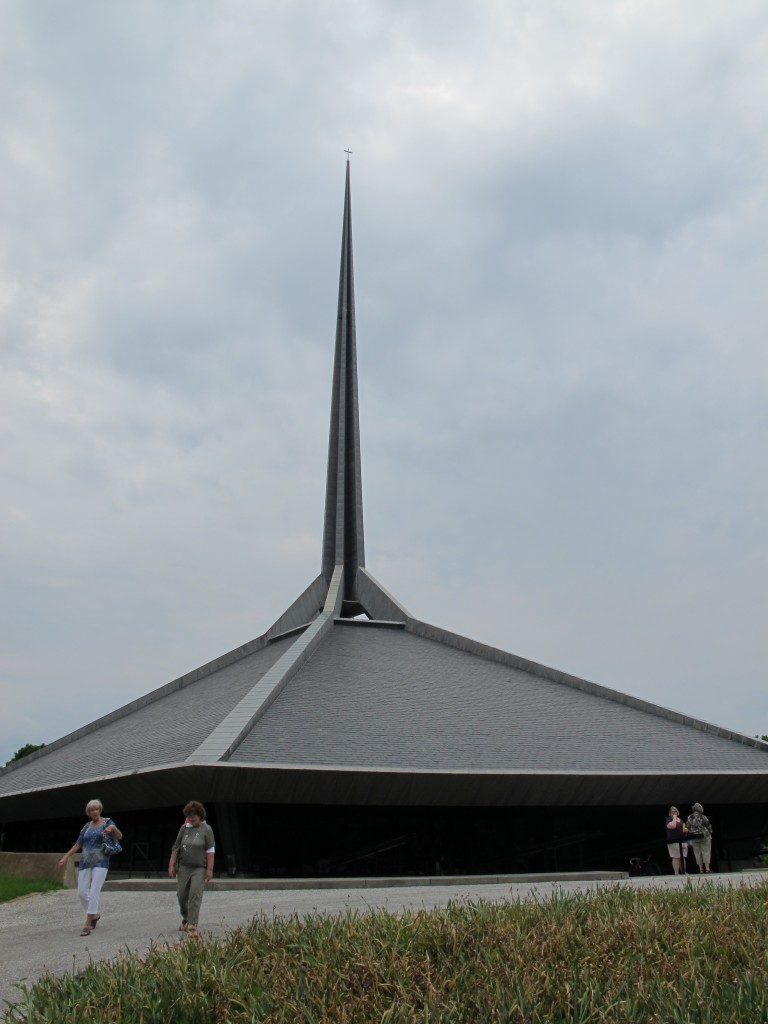 Exterior (photo by Ricky Berkey)
Exterior (photo by Ricky Berkey)
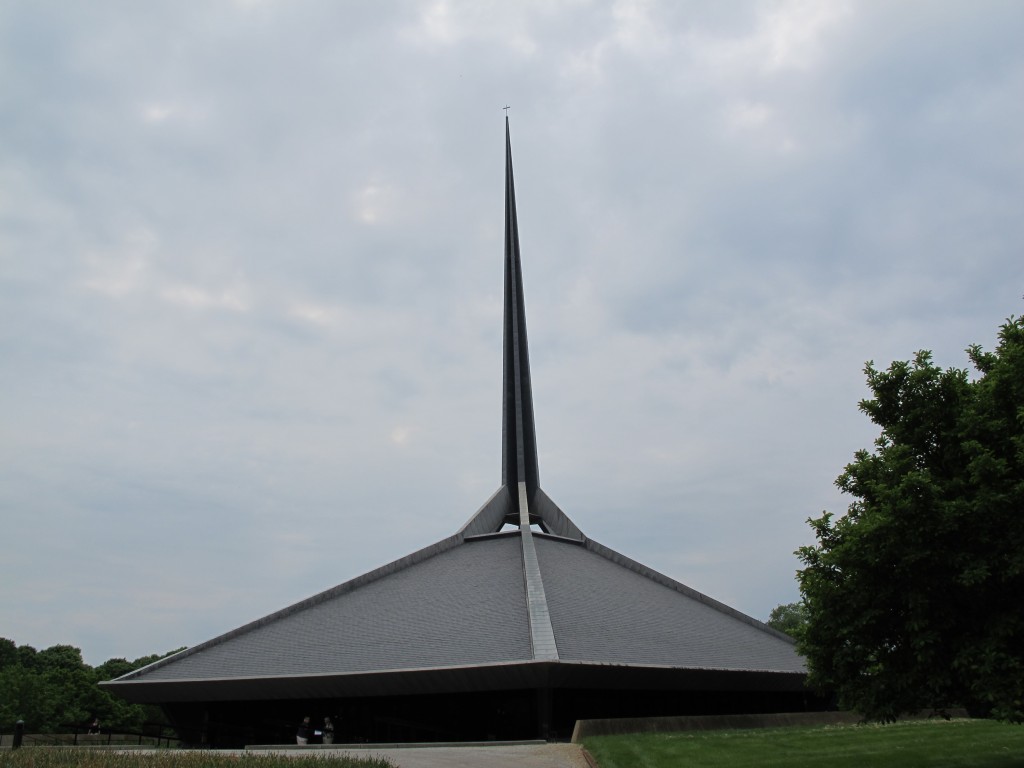 Exterior (photo by Ricky Berkey)
Exterior (photo by Ricky Berkey)
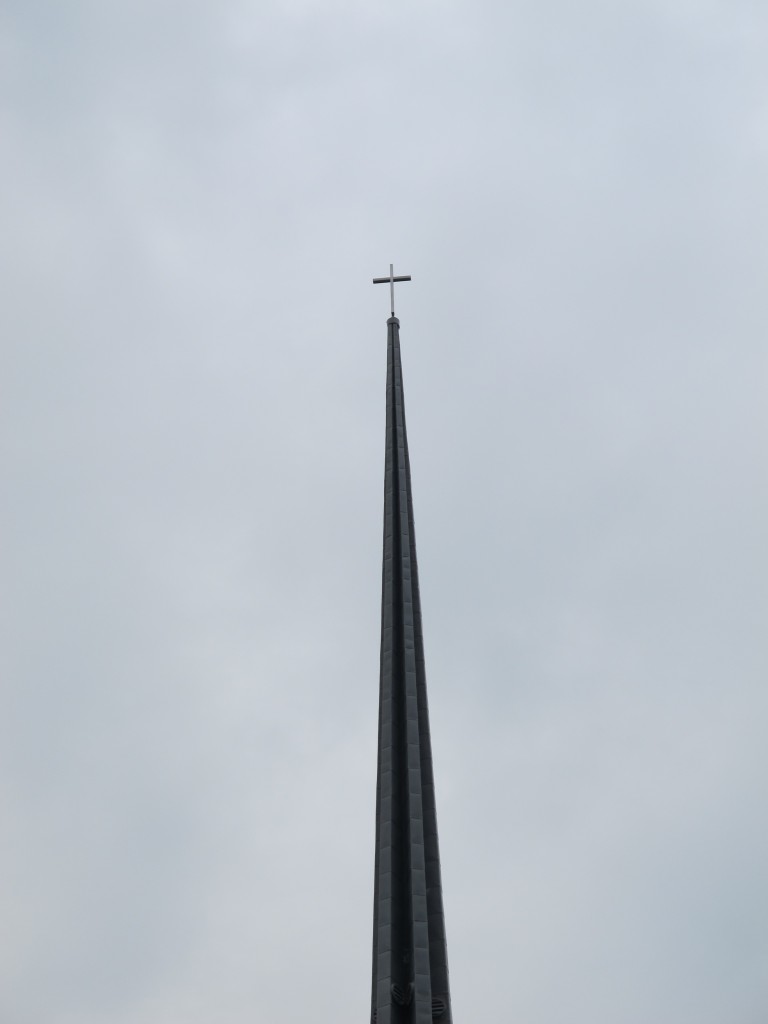 Cross at the top of church spire (photo by Ricky Berkey)
Cross at the top of church spire (photo by Ricky Berkey)
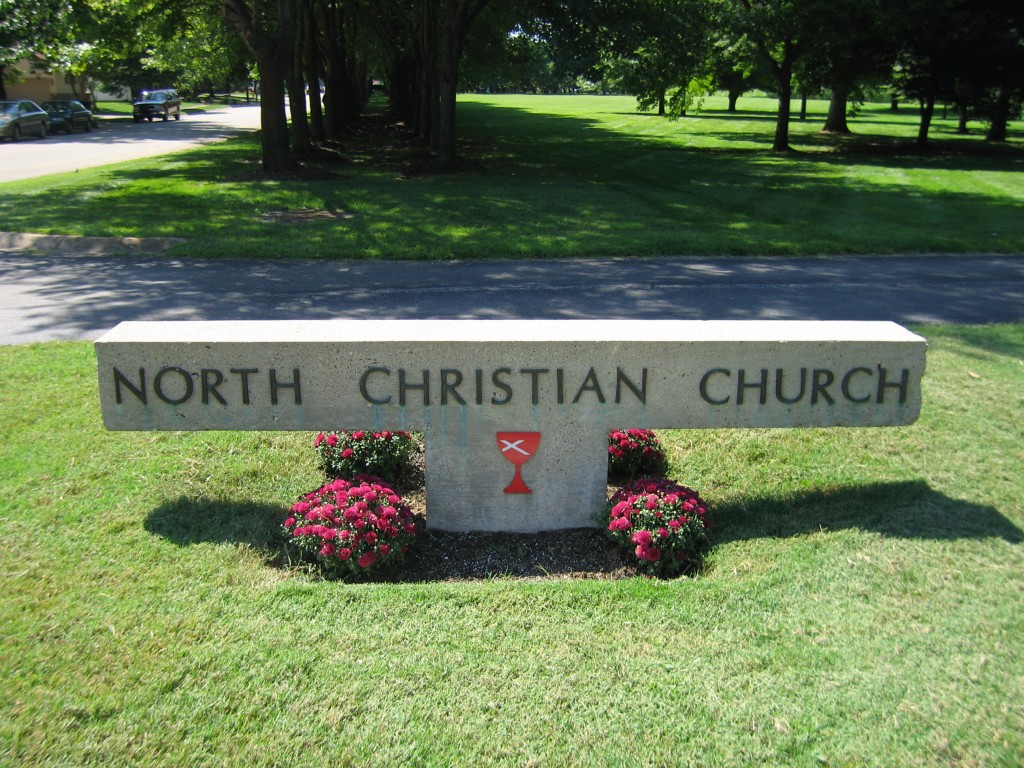 Entrance to the long driveway to the church (photo by Ricky Berkey)
Entrance to the long driveway to the church (photo by Ricky Berkey)
 Allee of red maples, a trademark of Dan Kiley landscapes (photo by Ricky Berkey)
Allee of red maples, a trademark of Dan Kiley landscapes (photo by Ricky Berkey)
 View from US 31 as you approach form the North (photo by Ricky Berkey)
View from US 31 as you approach form the North (photo by Ricky Berkey)
 Kiley’s “parking rooms” hiding the cars from the front entrance to the church (photo by Ricky Berkey)
Kiley’s “parking rooms” hiding the cars from the front entrance to the church (photo by Ricky Berkey)
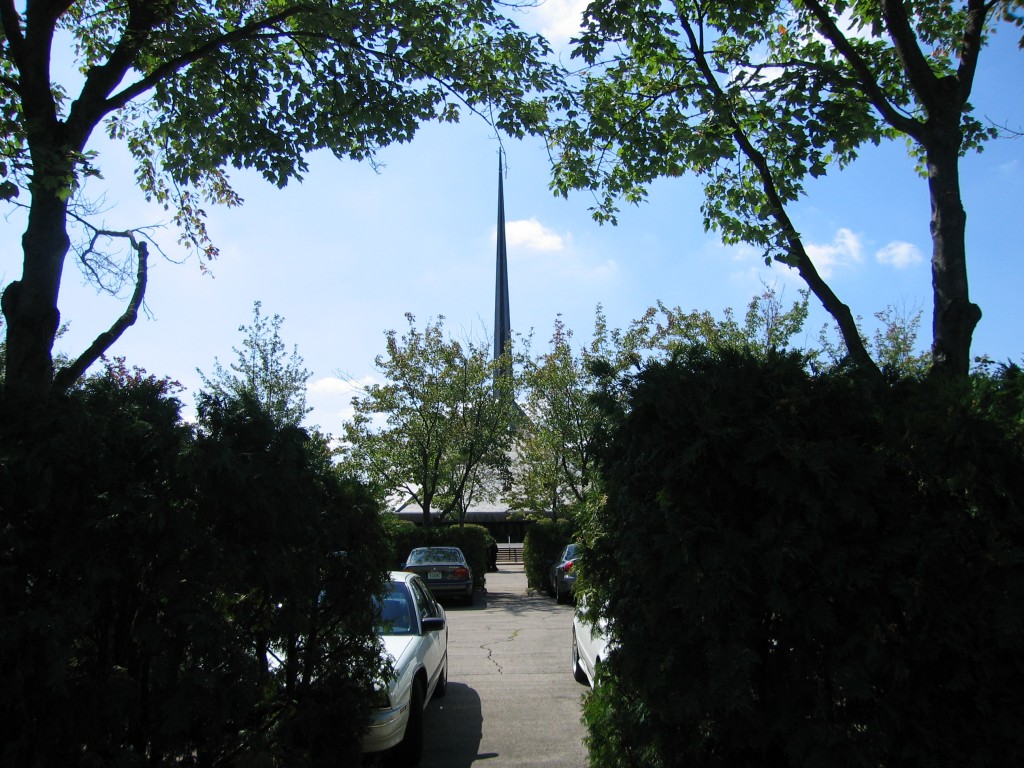 Path to the church from the center of the “parking rooms” (photo by Ricky Berkey)
Path to the church from the center of the “parking rooms” (photo by Ricky Berkey)
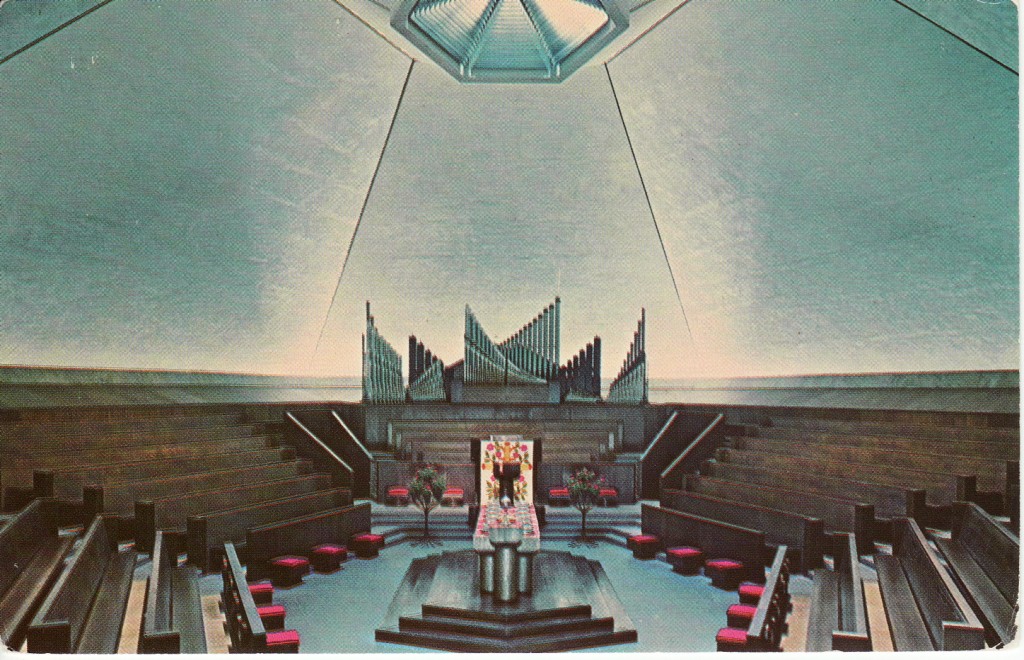 Sanctuary (Postcard image – do not copy)
Sanctuary (Postcard image – do not copy)
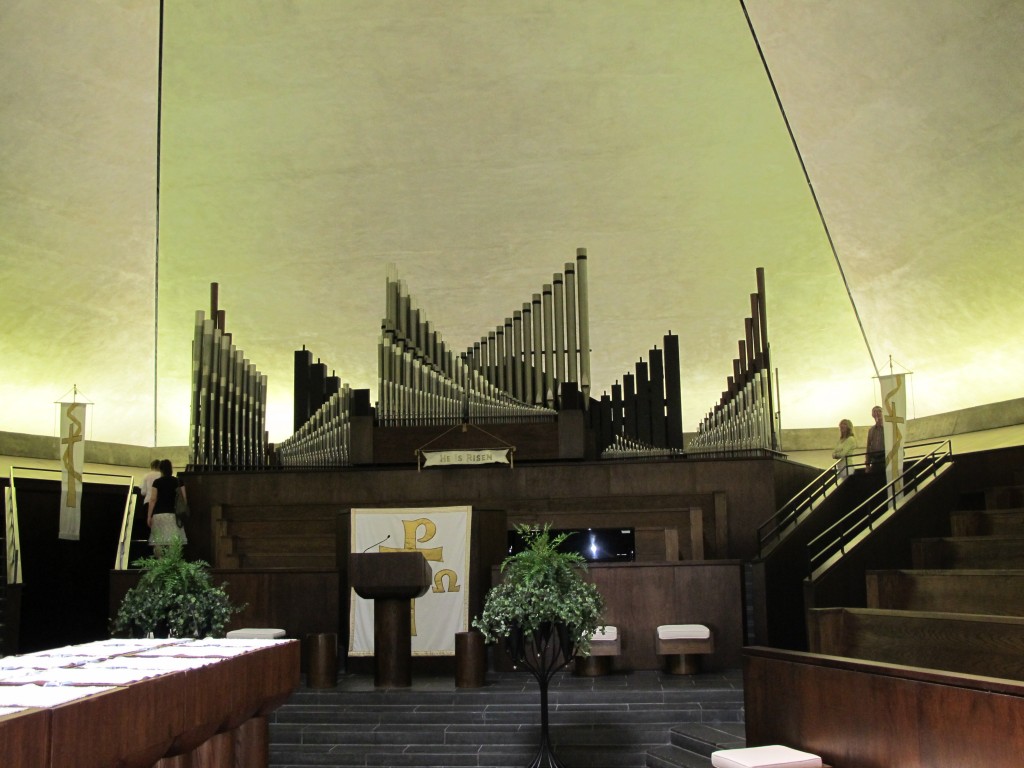 Holtkamp organ (photo by Ricky Berkey)
Holtkamp organ (photo by Ricky Berkey)
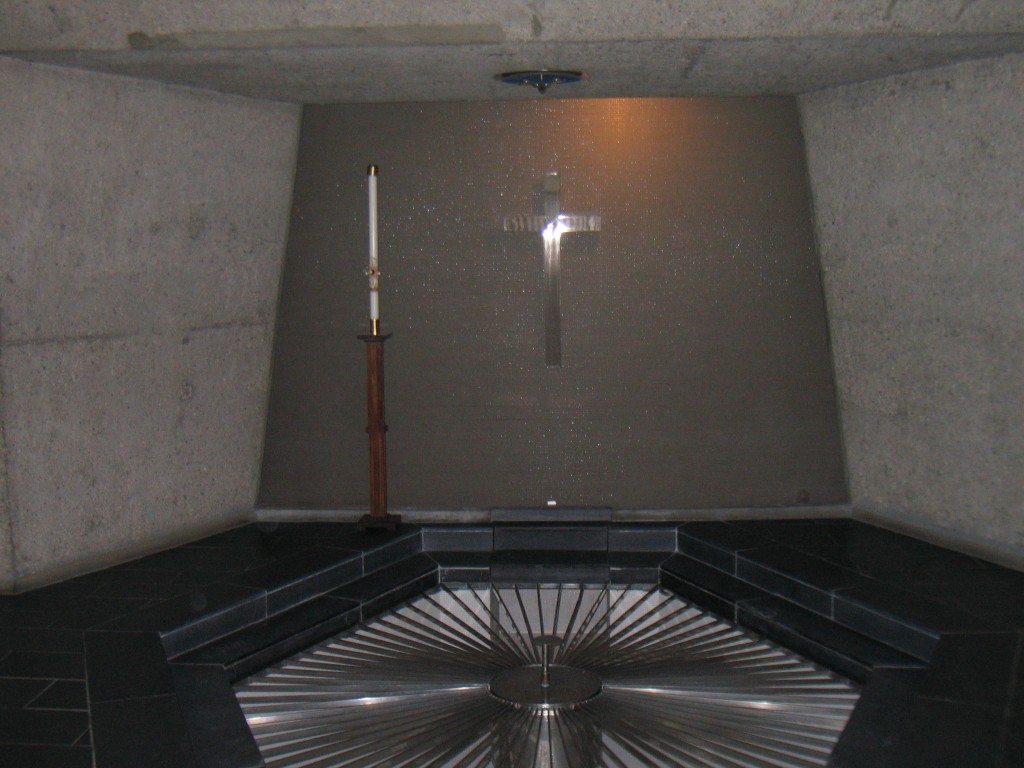 Baptismal area, designed by Alexander Girard (photo by Ricky Berkey)
Baptismal area, designed by Alexander Girard (photo by Ricky Berkey)
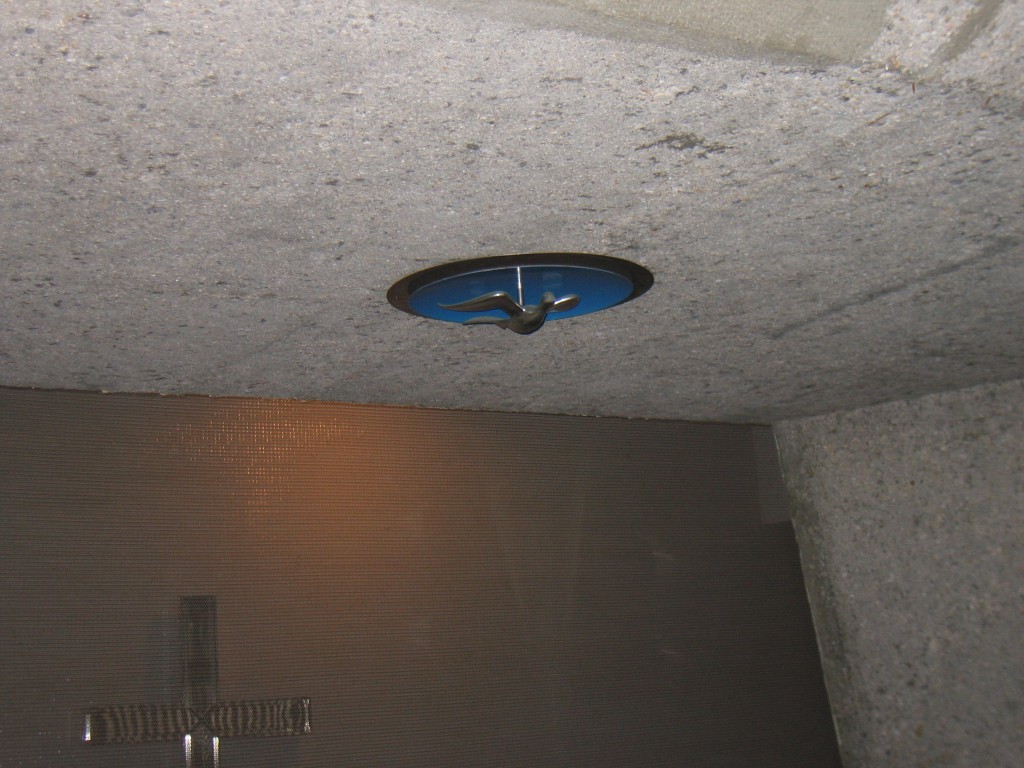 Baptismal area, designed by Alexander Girard (photo by Ricky Berkey)
Baptismal area, designed by Alexander Girard (photo by Ricky Berkey)
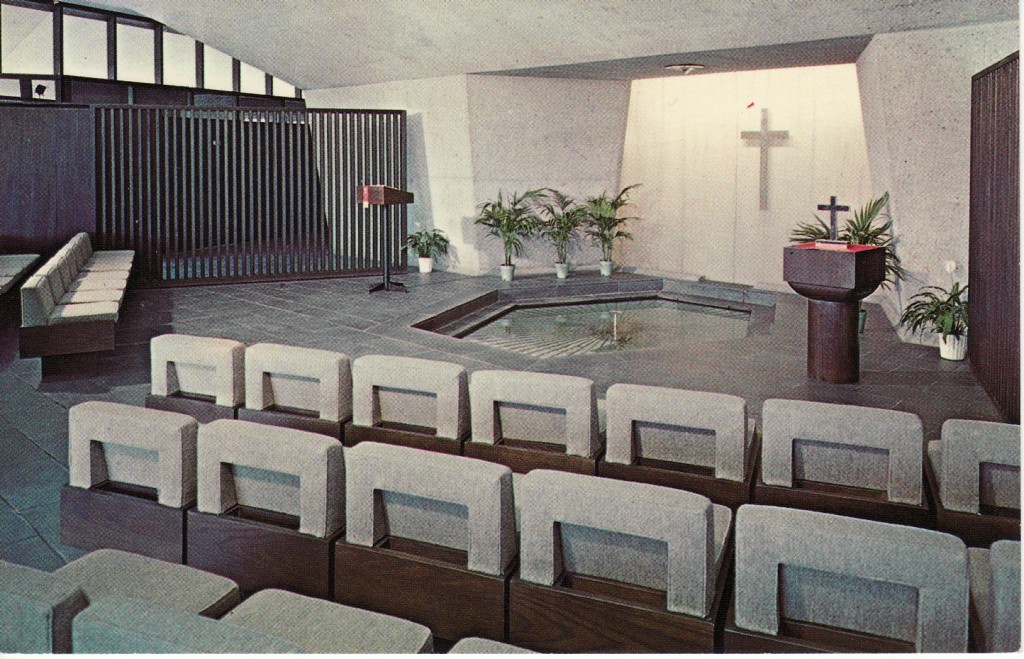 Chapel area (Postcard image – do not copy)
Chapel area (Postcard image – do not copy)
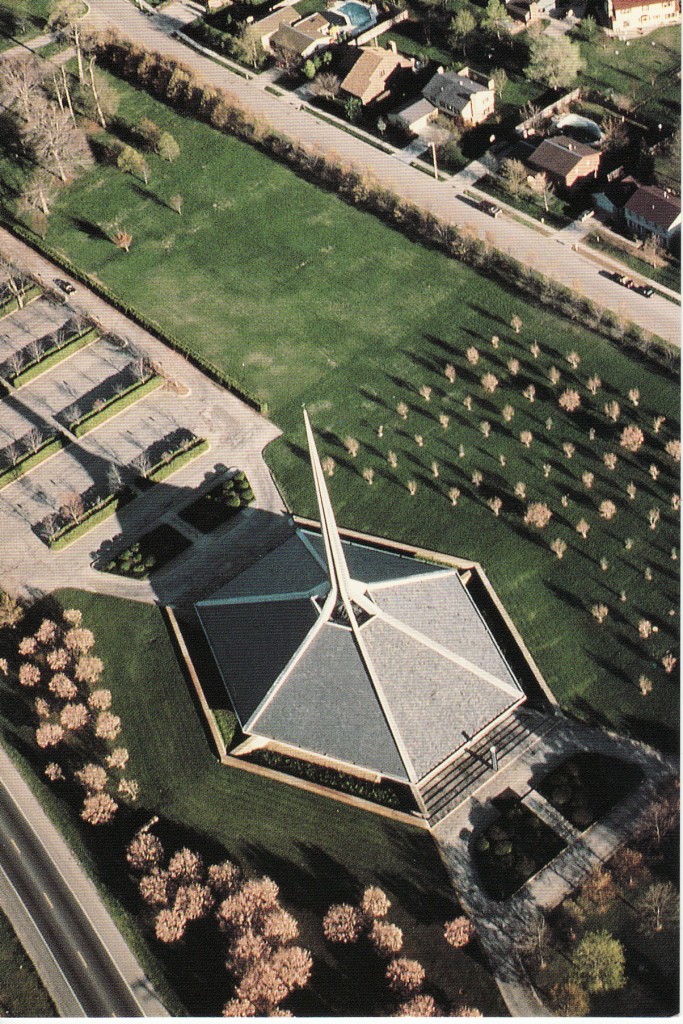 Aerial view (Postcard image – do not copy)
Aerial view (Postcard image – do not copy)
The Architect
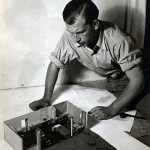 Eero Saarinen
Eero Saarinen
- Born in Kirkonummi, Finland on August 21st, 1910
- Died September 1st, 1961
- Cranbrook Academy
- Académie de la Grande Chaumière – Paris (1930)
- Yale University (1934)
- AIA Gold Medal Award
Eero Saarinen was a Finnish-American architect famous for taking modernism to different levels. He is most famous for his simple sweeping and arching sculptural shapes which were amazingly done before the era of computer-aided design and drafting had arrived. Unlike many of his contemporary architects, Eero Saarinen never had a particular defining style but insisted on a unique design to reach the architectural solution for each project.
He moved to the United States from Finland with his family in 1923 when he was 13. His father was Eliel Saarinen who had designed the campus at the Cranbrook Academy in Bloomfield Hills, Michigan as well as becoming the head of the Cranbrook’s Art, Design and Architecture School. Eero became a naturalized United States citizen in 1940. He studied sculpture and furniture design at Cranbrook and then went to Paris to study sculpture at the Académie de la Grande Chaumière in Paris, France. He completed his architectural study at Yale University in 1934 and began working with his father who had an architectural practice based out of his home at Cranbrook besides his academic work there.
He worked with his father from 1936-1950 with a wartime stint working for the Office of Strategic Studies (OSS) from 1942-1945. He gained national prominence on his own when he won the 1948 design competition for the Jefferson National Expansion Memorial (the iconic St Louis Gateway Arch).
After his fathers death, he began his own architectural firm in 1950 as Eero Saarinen & Associates. Besides his many buildings, he also designed interiors and furniture, especially well known for his Womb Chair and the Tulip Chair which were icons of the 50’s and still in production today. He had both studied at Cranbrook and taught there briefly where he had become close friends with Charles Eames who was also an architect as well as a furniture designer known for a number of very iconic chair designs. Eames later became a furniture designer associated with Herman Miller while Eero Saarinen designed furniture for Knoll (Florence Knoll was a graduate of Cranbrook). A number of both Charles Eames and Eero Saarinens furniture designs are still in production today.
Eero Saarinen died while undergoing surgery for a very unexpected brain tumor in 1961: he was only 51 and left behind at least 10 projects that were later completed by the Saarinen firm which was taken over by Kevin Roche and John Dinkeloo. Although his popularity as an architect fell out of favor for a few years there has been a recent surge of interest in his work and many critics have reassessed his work. Saarinen is now considered one of the masters of American 20th Century architecture. Eero Saarinen’s archive material has been donated to the Yale University Library by Kevin Roche.
Selected Eero Saarinen Projects
1940: Kleinhans Music Hall (with Eliel Saarinen) – Buffalo, New York
1940: Crow Island School (with Eliel Saarinen) – Winnetka, Illinois
1948: Womb Chair
1954: Irwin-Union Bank – Columbus, Indiana
1955: Kresge Auditorium (MIT) – Cambridge, Massachussets
1955: General Motors Technical Center – Warren, Michigan
1956: Tulip Chair (part of the “Pedestal” group which included arm and side chairs and tables)
1957: Miller House – Columbus, Indiana
1958 Concordia College (several buildings) – Fort Wayne, Indiana
1959: Yale Hockey Rink – New Haven, Connecticut
1962: Dulles International Airport – Washington D.C.
1962: Bell Labs – Holmdel, New Jersey
1962: TWA Terminal at JFK Airport – NYC
1964: North Christian Church – Columbus Indiana
1965: Gateway Arch – St Louis, Missouri
1965: CBS Building (“Black Rock”) – NYC
Historic Columbus
This is the former Caldwell mansion built in about 1904 by Columbus contractor George Caldwell. A very similar version of this house was built by Caldwell on the grounds of the 1904 St. Louis Worlds Fair. It became the worship home of North Christian church from 1956 until 1964 when their new church building was finally completed. It is now the site of a bank at the corner of 25th Street and Caldwell Boulevard.
Links/References
North Christian Church website
North Christian Church Pictorial History – from the official North Christian website
National Historic Landmark application – this was the information submitted to the National Park Service used in granting National Historic Landmark status
Cranbrook Academy – very influential school of art and design, often considered the Bauhaus of the United States
Knoll Inc – Eero Saarinen furniture designs still in production!
Saarinen Digital Archives at Yale
City of Columbus: official City of Columbus website
Columbus Indiana Architectural Archives
Columbus Indiana Architecture Digital Archives: A small portion of the Columbus Indiana Architectural Archives available online from the IUPUI digital library
3D Models of Columbus Architecture Executed in Google SketchUp:
The Republic Newspaper – Columbus, Indiana newspaper
Bartholomew County Public Library
Historic Columbus Website – David Sechrest’s tribute to Columbus History
Historic Columbus Message Board – a companion interactive forum to the David Sechrest historical website
Bartholomew County Historical Society
 Click HERE for a Calendar of Upcoming Events in the Columbus Area.
Click HERE for a Calendar of Upcoming Events in the Columbus Area.
Click HERE for information about Tours of Columbus Architecture and Design including the Miller House.
 Ricky Berkey
Ricky Berkey
Email me: rickyberkey@gmail.com

